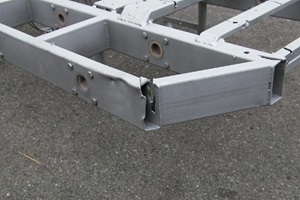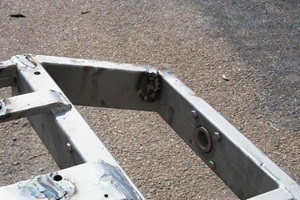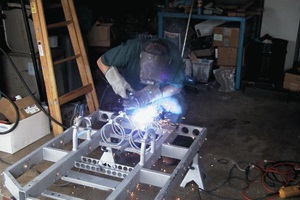While no emperor indicates someone's fate by giving a thumbs up or down, a panel of judges watching carefully over the competition may hold a player's life in their hands. Bloodthirsty Roman throngs are replaced by, well, bloodthirsty throngs lusting for torn pieces of metal. The Coliseum is replaced with the 48 ft. x 48 ft. x 2 ft. Battlebox Arena. Otherwise, BattleBots competitions have the same feeling as the old Roman death matches, complete with booby-traps. It's much more real and devastating than a scripted wrestling match.
All of these things have helped build the phenomenon that is Battlebots, a competition where robots do battle to incapacitate their opponent, either by making them immobile or by using weapons to cause a malfunction. Team Coolrobots (www.coolrobots.com), based out of Culver City, Calif., is co-owned by Christian Carlberg and is one of the most successful teams to grace the sport. Brian Roe and Luke Khanlian join him as the main core of the team and bring a wealth of engineering and machining experience to the group. Their most successful creation so far is Minion, a 325-lb. super-heavyweight division robot who won the BattleBots championship in 1999 and 2000 and had a second place showing in 2001.
 |
Before repairs: Minions left rear corner shows heavy damage to the chrome-moly square tubing.
|
Constructing a Gladiator - The Armor
A mechanical engineer with a degree from Cornell University, Carlberg worked in aerospace on the East Coast before moving to California. When he's not creating special effects for motion pictures (his day job) or building robots for other companies, Carlberg is finding ways to make Minion a more destructive and agile competitor. Getting to the level of success achieved by Team Coolrobots doesn't happen immediately. It requires a great deal of mechanical know-how, the right equipment and a lot of time.
"It doesn't hurt if you know how to turn on a lathe," says Carlberg. "Or to do metal working in a mill. When I started building robots in 1996, I really only had my degree to fall back on. So I forced myself to learn how to use the mill and lathe, I forced myself to weld. I just built on my skill base from there."
Teammate Brian Roe also contributed his wealth of tube bending and welding knowledge to the construction of Minion. Having worked extensively on dune buggies, Roe did much of the work on the frame.
Using a Millermatic all-in-one MIG (wire welding) system from Miller Electric Mfg. Co., the majority of the frame is welded out of 4130 chrome-moly tubing with a .012 wall thickness. The mild steel rectangular tubing that protects the wheels and the drivetrain is 1 in. x 3 in. x 1/8 in. thick. A roll cage made of 4130 chrome-moly tubing covered lexan and an aluminum plate helps protect the gas engine (used for the weapon) and other inner components.
"We picked the chrome-moly," explains Carlberg, "because it's a good, strong material. You can bend it, machine it, heat treat it, and it stays tough. We chose mild steel for the side walls because it absorbs a lot of damage. It's protecting the axles, which is critical."
 |
| After repairs: Ready for another battle, the deep gouges are filled and filed flat. |
While a previous model of the Millermatic was used on the original frame, a Millermatic 210 is currently used by Team Coolrobots to perform repairs on Minion. With a range of 30 – 210 amps, this particular Milleramtic model is designed for the type of light fabrication needed for Minion and can weld materials from 22 gauge to 3/8 in. in a single pass. When combined with a spool gun, the operator is able to shift from the standard MIG gun for steel wire to the spool gun for welding aluminum without reconnecting cables, saving time and hassle.
"A lot of people want to compete in this sport," says Carlberg. "You just have to have good equipment, and this (Millermatic) is a good place to start."
The Power to Go
Minion's six wheels are powered by two Lynch 3 HP "pancake" motors and a Vantec speed controller. Where most motors have a small diameter in relation to their length, pancake style motors have a longer, larger diameter. Because of the larger armature, more torque is being generated, which lowers the RPM.
"Whether you use a regular DC motor or a pancake motor," explains Carlberg, "the RPM is so high that you're not going to want to attach it directly to the wheel. You have to go through a gearbox, but if you're already starting with a lot of torque and a relatively low RPM, you don't have to go through as much gear reduction. You can do it all in one step by using this kind of motor."
Run on three 12-volt batteries, Minion is controlled by the same kind of remote control you would find with a model airplane or car. One operator controls the movement of the vehicle and another controls the weapon - in this case, an 8 HP Partner Fireman's emergency saw. The damage done by the weapon may be the juicy action the crowd wants, but Carlberg places success on the shoulders of another system: the drivetrain.
"Weapons don't win tournaments," says Carlberg. "Weapons will win you matches, but it's the drivetrain that wins tournaments. "
He's speaking to the importance of power and stability. A match may come down to which driver did the best job of out-maneuvering the other, and if your components are damaged or built weak from the beginning, you're at an immediate disadvantage. Team Coolrobots addressed this problem by moving Minion's six wheels to the inside of the frame and adding spacers that prevent weapons or obstacles from damaging an axle.
Obstacles, Enemies and Booby Traps
Some teams slap together a frame that may make it through one or two competitions. Others last slightly longer. The frame on Minion has remained the same for three years and now houses Minion v 2.0 - a revamped version of the original. Keeping a frame for that period of time isn't easy. Not only do enemies have spikes, saws and drills that can lay waste to your robot, but the Battlebox Arena is equipped with 22-in. saw blades that catch unsuspecting drivers off-guard. This leads to many repairs and hours of work put back into the robot after a competition.
 |
One of Team Coolrobots team members uses a Millermatic 210 to weld a new frame.
|
"The opponents and especially the arena weapons are getting more and more brutal," says Carlberg. "What we do is bang things back into shape or weld on a new piece of metal with the Millermatic 210. I added pieces to the framework to protect Minion from the Battlebox saws when they first were implemented in 1999. It's really aggravating though. It's like going through a sawmill. These saws can cut through titanium armor."
Other pieces have been added to Minion to combat pesky opponents and traps. A self-righting, air piston system flips Minion back over in the rare instance that the 325-lb. tank gets flipped over.
"Eventually," says Carlberg, "you're going to meet a worthy opponent who flips you. BattleBots is really the world's biggest game of rock/paper/scissors. You may have the almighty scissors robot and you may go through 20 paper robots, but you will eventually meet the dreaded rock robot. We've remained competitive. Minion is a steady robot who will compete every time.
The Best Kind of Reality TV
Forget the self-absorbed contestants who seem to be inundating your television sets on reality-based TV shows. BattleBots gives you the opportunity to watch a genuine competition where a little elbow grease and mechanical ingenuity decide who reigns as champion. Carlberg, Roe and Khanlian have been building robots under the name of Team Coolrobots since 1996. Minion could be compared to the Hulk Hogan of BattleBots - a crowned champion guaranteed to contend each time that it steps into the ring. Only this is real. And Hulk Hogan doesn't have to be welded by a Millermatic at the end of the day.
Visit www.coolrobots.com for more information on constructing your own robot. For information on the upcoming season of BattleBots, visit www.battlebots.com.
To purchase Miller products on-line or to download product spec sheets, visit Miller's website at www.MillerWelds.com.